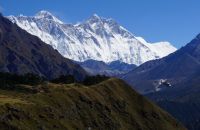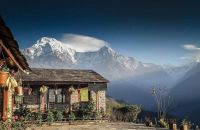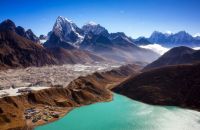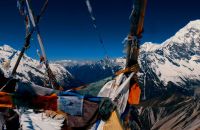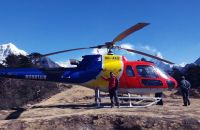Talk with our local travel specialist who can help organize your trip.
How to Plan Your Langtang Trek?
The Langtang region in Nepal offers breathtaking landscapes, rich biodiversity, and an authentic cultural experience, making it a popular choice for trekkers. Careful planning is vital to ensure a successful and enjoyable Langtang trek. This article provides a step-by-step guide to help you plan your Langtang trek effectively. This blog covers everything from choosing the right time to visit, obtaining necessary permits, selecting the best trekking route, packing essentials, and ensuring your safety throughout the journey.
Selecting the Perfect Time for Langtang Trek
The Langtang region in Nepal offers breathtaking landscapes and exciting trekking opportunities. The area experiences four distinct seasons, each with weather conditions and trekking advantages. Let's discuss the seasons and their pros and cons to help you choose the ideal time for your trek.
Spring Season (March to May)
Spring is a popular time for trekking in Langtang due to mild temperatures and blooming rhododendron forests. Here are the pros and cons:
Pros
- Pleasant temperatures during the day, ranging from 10°C to 20°C.
- Clear skies and excellent visibility offer stunning views of the Himalayas.
- Vibrant landscapes with colorful flowers, including rhododendrons.
- The chance to witness local festivals, like Buddha Jayanti.
Cons
- Crowded trails, especially during the peak season (April).
- Occasional rainfall, which can make the trails muddy and slippery.
- Fluctuating weather patterns require flexibility in your trekking plans.
Summer/Monsoon season (June to August)
The summer season in Langtang coincides with the monsoon season, bringing rain showers and increased humidity. Here are the pros and cons:
Pros
- Lush greenery and blooming vegetation due to the rainfall.
- Fewer trekkers on the trails, resulting in a quieter experience.
- Lower trekking permit fees compared to peak seasons.
Cons
- Frequent rain showers and cloudy weather limit mountain views.
- Leeches and bugs may be more prevalent during this time.
- Landslides and trail obstructions are possible due to heavy rain.
Autumn Season (September to November)
Autumn is the best time for the Langtang trek, offering pleasant weather and clear skies. Here are the pros and cons:
Pros
- Stable weather conditions with mild temperatures (10°C to 15°C).
- Crystal-clear mountain views and excellent visibility.
- Festive atmosphere due to popular Hindu festivals like Dashain and Tihar.
- The chance to witness the golden harvest season in rural areas.
Cons
- Busier trails and teahouse accommodations may require early bookings.
Winter Season (December to February)
Winter in Langtang brings colder temperatures and an occasional snowfall. Here are the pros and cons:
Pros
- Peaceful trekking experience with fewer crowds.
- Stunning views of snow-capped mountains and frozen waterfalls.
- Lower trekking permit fees compared to peak seasons.
Cons
- Sub-zero temperatures, particularly at higher altitudes.
- Limited teahouse availability due to seasonal closures.
- Higher chances of snow blocking higher passes, making some routes inaccessible.
Here are some recommendations for the ideal time to visit the Langtang region:
- If you prioritize clear mountain views and a lively atmosphere, consider visiting during autumn. This season offers moderate trekking difficulty and provides excellent visibility of the majestic Himalayas.
- For those who appreciate vibrant landscapes and cultural experiences, spring is the perfect time to visit. Even though the possibility of crowded trails, pleasant temperatures, blooming rhododendron forests, and local festivals will reward you.
- The winter season is ideal if you prefer a quieter trekking experience and lower costs. However, be prepared for cold temperatures and limited teahouse options. This season offers a peaceful atmosphere, stunning views of snow-capped mountains, and the opportunity to explore frozen waterfalls.
Featured Trips
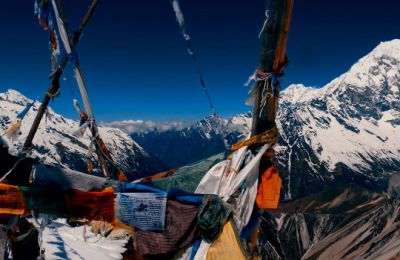
Langtang Valley Trek - 11 days
Langtang Valley Trek is best suited for those looking for a short trekking adventure with amazing Himalayan views and unique mountain culture. Explore Langtang National Park and experience Tamang culture.
Inquire Now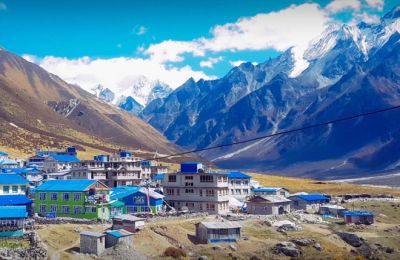
Langtang Helicopter Tour - 1 day
Langtang Helicopter Tour takes you to Langtang National Park and Tamang Villages. Fly close to Langtang Himalayan Range and reach the Tibetan border in 1 day.
Inquire NowWhere to travel next?
Get help from our travel specialists for holiday ideas that matches your interests.
Obtaining Trekking Permits
When trekking in the Langtang region of Nepal, you must obtain specific permits and documents.
Langtang National Park Entry Permit
This permit allows access to the Langtang National Park. You can get it from Kathmandu or the Langtang National Park entry point in Dhunche. It'll cost approximately NPR 3,000 (USD 30) per person.
Trekking Information Management System (TIMS) Card
As per the revised TIMS provision effective from March 31, 2023, you need a trekking agency issued TIMS Card if you're trekking in the Langtang region. It'll cost NPR 1,000 for travelers from SAARC and NPR 2,000 for other countries' travelers.
If you still need clarification, let us know and we'll clear your doubts regarding TIMS Card.
Required Documentation
Passport and Visa
You need a valid passport and a Nepali visa. You can obtain it in advance or upon arrival in Nepal. Costs vary based on the duration of stay.
Choosing the Right Trekking Route
The Langtang region in Nepal offers several popular trekking routes, each with its highlights, difficulty level, and duration. Here's an overview of two well-known trekking routes:
Langtang Valley Trek
Highlights: The Langtang Valley Trek is a scenic route that takes you through beautiful valleys, dense forests, and charming Tamang villages. Some of the major highlights include panoramic mountain views, Langtang village, Kyanjin Gompa (a Buddhist monastery), and the opportunity to witness the local Tamang culture.
Difficulty: Moderate with some uphill combs and rough terrain but is generally suitable for trekkers with a moderate fitness level.
Duration: The average time for the Langtang Valley Trek is 7 -10 days, depending on the starting point and side trips taken.
Gosaikunda Trek
Highlights: The Gosainkunda Trek combines natural beauty with religious and cultural significance. The route takes you to the sacred Gosainkunda Lake, surrounded by snow-capped peaks. It offers breathtaking views, encounters with traditional Tamang and Sherpa communities, and a chance to learn about Hindu and Buddhist traditions.
Difficulty: Moderate to challenging as the trek involves steep ascents, high-altitude sections, and some technical sections near the lake. It is suitable for experienced trekkers with those with a good fitness level.
Duration: The average time for the Gosaikunda Trek is 6-9 days, depending on the starting point and side trip taken.
Preparing Your Physical Fitness and Training
To enhance your physical fitness before embarking on a trek in the Langtang region and prepare for the altitude challenges, consider the following tips and recommendations
Cardiovascular Exercises
- Engage in regular aerobic exercise like jogging, cycling, swimming, or brisk walking to improve cardiovascular endurance.
- Progressively increase the intensity and workout duration to build stamina and endurance.;
Strength Training
- Include strength training exercises to build muscular strength and endurance.
- Focus on exercises that strengthen your legs, core, and upper body, as trekking involves carrying a backpack and navigating challenging terrain.
- Incorporate exercises such as squats, lunges, step-ups, planks, and push-ups into your routine.
Acclimatization and Altitude Sickness
- Acclimatization is crucial to prevent altitude sickness. It allows your body to adjust gradually to higher altitudes.
- Plan your itinerary with proper acclimatization days, ensuring a gradual increase in altitude and allowing time for your body to adapt.
- Avoid excessive alcohol consumption and smoking, as they can worsen altitude sickness symptoms.
- Listen to your body and be attentive to symptoms of altitude sickness, such as difficulty breathing, headache, or nausea. If symptoms worsen, descend to lower altitudes immediately.
Mental Preparation
- Trekking at high altitudes can be mentally challenging. Prepare yourself by visualizing successful trekking experiences and maintaining a positive mindset.
- Develop mental resilience by practicing meditation, deep breathing exercises, or yoga to help manage stress and stay focused during the trek.
Essential Gear and Packing List
When preparing for a trek in the Langtang region, it's essential to pack the right gear to ensure comfort, safety, and enjoyment. Here's a comprehensive packing list:
Clothing
- Base layers (T-shirts)
- Insulating layers (Fleece jackets)
- Down jacket
- Waterproof jacket and trousers
- Trekking pants
- Hiking shorts
- Underwear and socks
- Warm hat and gloves
- Sun hat
- Buff or Bandana
Footwear
- Trekking boots
- Hiking socks
- Sandals or camp shoes
Trekking Gear
- Sleeping bag
- Backpack
- Trekking poles
- Headlamp
Toiletries and Miscellaneous
- First aid kit (Personal medications, bandages, and blister treatments)
- Sunglasses
- Sunscreen and lip balm with SPF
- Insect repellent
- Toothbrush, toothpaste, shampoo
- Personal hygiene items (Wet wipes, hand sanitizer, toilet paper, and a towel)
- Water bottle (reusable)
Keynote: Choose gear that suits your specific needs and preferences. When selecting items, research reputable outdoor brands such as The North Face, Patagonia, Columbia, and Osprey. Be mindful of the weight restrictions for your backpack, aiming for a total weight (including gear, food, and water) of around 10-15% of your body weight.
Tips for efficient packing:
- Use packing cubes or compression sacks to organize and maximize space.
- Prioritize lightweight and multi-purpose items.
- Minimize duplicate items and consider shared gear among trekking partners.
- Leave unnecessary items behind to reduce weight and optimize comfort.
Featured Trips
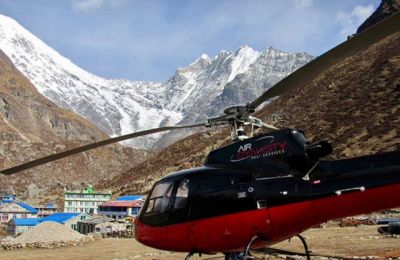
Langtang Trek Helicopter Return - 8 days
Langtang Trek Helicopter Return is a luxurious adventure in the wilderness of the Langtang region. The best part of this tour is returning from Kynjing Gompa to Kathmandu via Helicopter ride with panoramic views of the mountains and the green hills underneath.
Inquire Now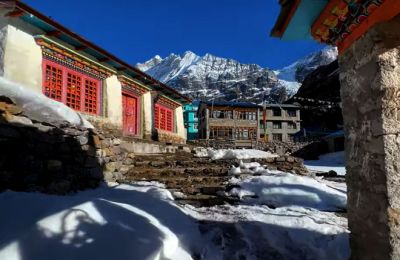
Short Langtang Trek - 9 days
Short Langtang trek takes you to the lush green terrain and villages of the Langtang region and is one of the shortest alternatives compared to other Langtang treks.
Inquire NowWhere to travel next?
Get help from our travel specialists for holiday ideas that matches your interests.
Accommodation and Food
Teahouses are the recommended option for most trekkers in the Langtang region. They provide basic yet comfortable accommodation, allowing you to travel light and have access to meals and social interaction with other trekkers. Most of the teahouse serves local cuisine, including traditional Nepal dishes. Dal Bat (rice with lentils and vegetables) is widely available in teahouses. Other options include momos (dumplings), thukpa (noodle soup), snacks, and tea.
Budgeting and Cost Consideration
When planning a Langtang trek, it's essential to consider the costs and create a budget accordingly. Below is a summary of the main cost considerations:
Permit Costs
- Langtang National Park Entry Permit: USD 30 per person
- TIMS Card: USD 20 per person
Accommodation Costs
Teahouse/ Lodges accommodation costs typically range from USD 5 to USD 20 per night, depending on the location and facilities. Prices may be higher during peak seasons.
Meal Costs
Budget around USD 10 to 20 per day for three meals, depending on the menu choices and location.
Transportation Costs
Bus/Jeep fare from Kathmandu and Syabrubesi (starting point of the trek) approximately costs USD 10 to 20 per person, one way.
Potential additional expenses:
- Guide and Porter: If you hire a guide or porter, their fees range from USD 20 to 30 per day, including accommodation and meals.
- Trekking Equipment Rental: If you need to rent equipment such as trekking poles or sleeping bags, include the associated costs in your budget planning.
- Travel insurance: It is strongly advised to have travel insurance that covers trekking activities, including emergency medical evacuation.
- Additional Meals and Snacks: If you have specific dietary preferences or require extra meals or snacks, allocate a portion of your budget accordingly.
- Tips and Gratuities: It's customary to tip your guide and porter as a gesture of appreciation for their services.
Keynote: It's advisable to have some extra cash for unexpected expenses or emergencies. A well-planned budget will help you manage costs and ensure a smooth trekking experience. Also, you can look at an informative article on the Langtang Valley Trek Cost. It offers detailed insights and guidance for a comprehensive understanding of the expense involved during the Langtang trek.
Safety Measures and Emergency Preparedness
- Trek with a licensed guide or experienced trekking company.
- Stay informed about weather conditions and forecasts before and during the trek.
- Trek in groups or with a partner to enhance safety and avoid getting lost.
- Follow established trekking routes and avoid shortcuts or unmarked trails.
- Maintain a suitable pace and listen to your body to prevent altitude sickness and overexertion.
- Ensure optimal hydration by drinking plenty of water and carrying water purification tablets or a filter.
- Carry sunscreen, a hat, and sunglasses to protect yourself from the sun.
- Familiarize yourself with the symptoms and prevention of altitude sickness.
- Carry emergency contact numbers and inform someone about your trekking itinerary.
- Be prepared for natural disasters and follow safety protocols if necessary.
- Stay updated on local regulations and guidelines for trekking in the area.
Final Thoughts
Following this comprehensive guide, you can confidently plan your Langtang trek and make the most of your experience. Remember to consider the weather, choose the correct trekking route, pack the essentials, prioritize your safety, and immerse yourself in the awe-inspiring beauty of the Langtang region.
Contact us now for detailed information, personalized itineraries, and expert guidance on planning your Langtang trek. Our team will assist you every step of the way, ensuring an unforgettable adventure tailored to your preferences.
- Written by: Sudina Manandhar
Updated: Jun, 10, 2023





